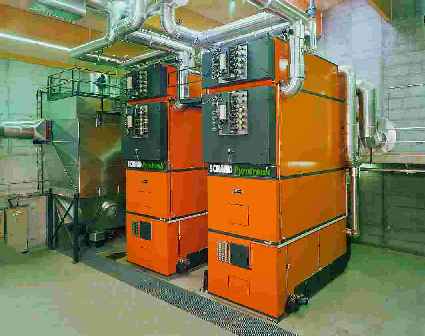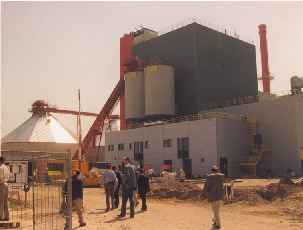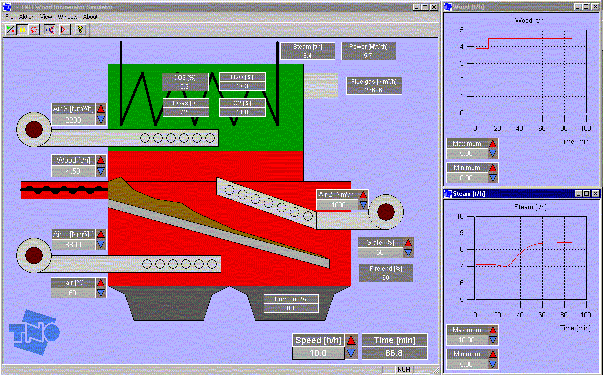Different biomass combustion systems are available for industrial purposes. Broadly, they can be defined as fixed-bed combustion, fluidised bed combustion, and dust combustion.
Fixed-bed combustion
Fixed-bed combustion systems include grate furnaces and underfeed stokers. Primary air passes through a fixed bed, where drying, gasification, and charcoal combustion take place in consecutive stages.
The combustible gases are burned in a separate combustion zone using secondary air.
 |
| Two 3.2 MWth grate furnaces for wood chips, used for district heating in Interlaken, Switzerland. (Courtesy of Schmid AG, Switzerland) |
Grate furnaces are appropriate for burning biomass fuels with high moisture content, different particle sizes, and high ash content. Usually, the capacity goes up to around 20 MWth. Mixtures of wood fuels can be used but straw, cereals, and grasses may cause problems due to their different combustion behaviour, their low moisture content, and their low ash melting point. The grate and walls can be water-cooled to avoid slagging problems.
The design and control of the grate are aimed at guaranteeing smooth transportation and even distribution of the fuel and a homogeneous primary air supply over the whole grate surface. Irregular air supply may cause slagging, and higher amounts of fly ash, and may increase the oxygen needed for complete combustion.
Underfeed stokers represent a cheap safe technology for small- and medium-scale systems up to about 6 MWth. The fuel is fed into the combustion chamber by screw conveyors from below and is transported upwards on a grate. Underfeed stokers are suitable for biomass fuels with low ash content (wood chips, sawdust, pellets) and small particle sizes (up to 50 mm). Underfeed stokers have a good partial load behaviour and simple load control. Load changes can be achieved more easily and quickly than in grate furnaces because there is better control of the fuel supply.
Fluidised bed combustion
In a fluidised bed, biomass fuel is burned in a self-mixing suspension of gas and solid bed material (usually silica sand and dolomite) in which air for combustion enters from below. Depending on the fluidisation velocity, bubbling and circulating fluidised bed combustion can be distinguished.
The intense heat transfer and mixing provide good side conditions for complete combustion with low excess air demand. Using internal heat exchanger surfaces, flue gas re-circulation, or water injection, a relatively low combustion temperature is maintained in order to prevent ash sintering in the bed.
Due to the good mixing achieved, fuel flexibility is high, although
attention must be paid to particle size and impurities contained in the fuel. Partial load operation of fluid bed combustion plants is limited because of the demand for the process.
 |
| A 25 MWe woodchip fired power plant in Cuijk, Netherlands with BFB boiler |
Low NOx emissions can be achieved by good air-staging, good mixing, and a low requirement for excess air. Moreover, additives (eg limestone for sulphur removal) work well due to the good mixing behaviour. The low excess air amounts required reduce the flue gas volume flow and increase combustion efficiency. Fluid bed combustion plants are of special interest for large-scale applications (normally exceeding 30 MWth). For smaller plants, fixed bed systems are usually more cost-effective. One disadvantage is the high dust loads taken in with the flue gas, which make efficient dust precipitators and boiler cleaning systems necessary. Bed material is also lost with the ash, making it necessary to periodically add new bed material.
Dust combustion
Dust combustion is suitable for fuels available as small, dry particles such as wood dust. A mixture of fuel and primary combustion air is injected into the combustion chamber. Combustion takes place while the fuel is in suspension; the transportation air is used as primary air. Gas burnout is achieved after secondary air addition. An auxiliary burner is used to start the furnace. When the combustion temperature reaches a certain value, biomass injection starts and the auxiliary burner is shut down. Due to the explosion-like gasification process of the biomass particles, careful fuel feeding is essential.
Fuel/air mixtures are usually injected tangentially into a cylindrical furnace to establish a rotational vortex flow. This motion can be supported by flue gas re-circulation in the combustion chamber. Due to the high energy density at the furnace walls and the high combustion temperature, the muffler should be water-cooled. Fuel gasification and charcoal combustion take place at the same time because of the small particle size. Therefore, quick load changes and efficient load control can be achieved. Since the fuel and air are well-mixed, only a small amount of excess air is required. This results in high combustion efficiencies.
Need for research
Combustion technologies can be improved to further reduce the total costs of heat and/or power produced and to maximise safety and ease of operation. The need for innovation is also driven by the wish to burn new biomass fuels, such as pellets, energy crops, and waste wood.
Instead of performing expensive and time-consuming test runs, CFD modelling is increasingly used to calculate flow, temperature, and residence time distributions as well as two-phase flows (flue gas and ash particles) in biomass furnaces and boilers, and to evaluate the impact of design on combustion quality and emissions.
Ash-related technical problems such as particulate formation, deposit formation, and corrosion as well as slagging require ongoing R&D. To reduce maintenance and repair costs and to increase the availability of installations, the mechanisms responsible for problems as well as appropriate primary and secondary measures to prevent them have to be thoroughly understood.
There are still gaps in our knowledge about the thermodynamic and physical properties of certain elements, compounds, and multi-component/multi-phase systems, as well as the chemical reactions related to ash, NOx and SOx formation. Improvement of basic data and models is therefore necessary.
 |
| A computer simulation program, used to evaluate the dynamic reaction of a step grate combustion system on sudden fluctuations in woodfuel properties. |


